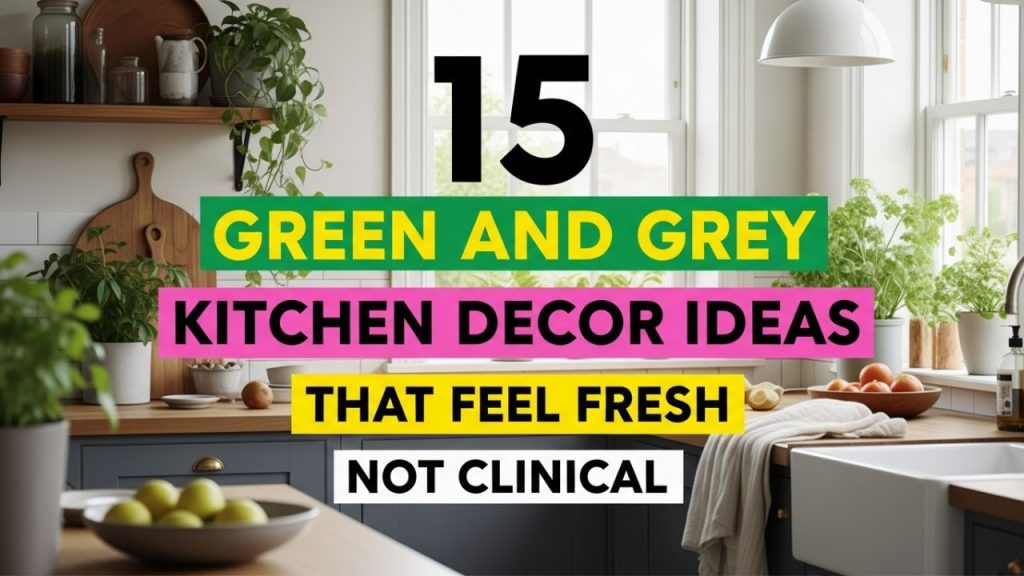A green and grey kitchen doesn’t have to feel cold, boring, or sterile. When styled thoughtfully, this color combo can feel cozy, calm, and full of personality.
Whether you’re planning a full renovation or a quick weekend refresh, these 15 green and grey kitchen decor ideas will help you strike that perfect balance between earthy elegance and modern minimalism — without tipping into a clinical or lifeless look.
Let’s dive into ideas that actually work — with reasons why, how to do them right, and what to avoid.

Table of Contents
1. Sage Green Cabinets with Soft Grey Walls
Why it works: Sage green is calming and organic, while soft grey walls make the green pop without stealing focus.
How to do it:
- Choose a muted sage with a matte finish.
- Pair with a warm grey paint that has beige undertones (greige).
- Add brass or wooden handles for warmth.
What not to do:
- Avoid cool-toned greys that make the green feel dull.
- Don’t go too dark unless your kitchen has lots of light.
Also Read: 21 Small-Space Boho Home Decor Ideas For You
2. Two-Tone Cabinets: Grey Base + Olive Green Uppers
Why it works: The grey base grounds the space, while olive green adds vibrancy on top without overwhelming.
How to do it:
- Use a mid-tone neutral grey for lower cabinets.
- Select olive or moss green for uppers — matte or satin finish preferred.
- Connect with matching green accessories (e.g. utensils, planters).
What not to do:
- Don’t skip a color test under your kitchen lights.
- Avoid high-gloss paints for this look — it can feel dated.
3. Green Tiled Backsplash with Grey Grout
Why it works: Adds texture and visual interest while keeping things cohesive.
How to do it:
- Choose handmade or zellige tiles in forest or jade green.
- Use medium grey grout to highlight tile shapes subtly.
- Install in a herringbone or vertical stack pattern.
What not to do:
- Avoid white grout — it’ll look too clean and sterile.
- Don’t over-accessorize around the backsplash.
4. Charcoal Grey Walls with Light Green Accents
Why it works: Creates contrast and mood while keeping it stylish.
How to do it:
- Paint one or two walls in deep charcoal grey.
- Add mint or light green bar stools, vases, or dishware.
- Use warm lighting to soften the overall feel.
What not to do:
- Don’t go full charcoal in small kitchens.
- Avoid neon greens — they clash with charcoal.
5. Concrete Grey Countertops with Green Cabinetry
Why it works: Concrete’s raw edge pairs beautifully with earthy green tones for a modern-rustic look.
How to do it:
- Use quartz or real concrete counters in light-medium grey.
- Pair with deep green cabinets — think hunter, emerald, or bottle green.
- Balance with natural wood or white shelving.
What not to do:
- Don’t pair with dark grey concrete — it can feel heavy.
- Avoid chrome fixtures — they break the natural vibe.
6. Grey Floor Tiles with Green Kitchen Island
Why it works: Grounds the space and adds a beautiful central pop of color.
How to do it:
- Go for large-format matte grey tiles.
- Paint your island in a bold green (try lacquer for shine).
- Add gold or copper pendant lights above.
What not to do:
- Avoid patterned flooring — it may compete with your island.
- Don’t mix too many metal finishes.
7. Green and Grey Geometric Wallpaper
Why it works: Brings energy and pattern into a neutral kitchen without overwhelming.
How to do it:
- Apply on one accent wall or backsplash zone.
- Look for watercolor or soft-edged patterns.
- Keep cabinetry and counters simple.
What not to do:
- Avoid shiny or overly graphic wallpaper.
- Don’t apply near wet zones unless it’s waterproof.
8. Open Shelving with Green Accents Against Grey Wall
Why it works: A practical and stylish way to break up blocks of color.
How to do it:
- Install wooden or matte black shelves.
- Style with green glassware, bowls, or herbs.
- Use a soft grey wall as your base.
What not to do:
- Don’t overcrowd the shelves.
- Avoid too many mismatched greens.
9. Matte Grey Appliances with Green Cabinetry
Why it works: Keeps the look cohesive and minimal without making the appliances disappear.
How to do it:
- Choose matte or brushed steel appliances.
- Pair with muted green cabinetry (pistachio or sage).
- Add matte black or brass handles for depth.
What not to do:
- Avoid shiny silver appliances — they’ll feel too cold.
- Don’t use overly bright greens.
10. Green Pendant Lights Over Grey Counters
Why it works: Adds an unexpected splash of color right where eyes go first.
How to do it:
- Choose bold or vintage-style green pendants.
- Hang them low over counters or islands.
- Use warm LED bulbs to soften.
What not to do:
- Don’t use cool-white lighting.
- Avoid clashing green tones with cabinets.
11. Grey Shiplap or Beadboard Walls with Green Accents
Why it works: Adds a cozy, textural farmhouse or coastal feel.
How to do it:
- Paint shiplap in warm grey tones.
- Pair with green bar stools, curtains, or pots.
- Add butcher block or white countertops.
What not to do:
- Don’t use cold greys — makes it feel uninviting.
- Avoid mixing shiplap with heavy industrial styles.
12. Green and Grey Tile Flooring Pattern
Why it works: A bold, eye-catching foundation that sets the tone.
How to do it:
- Try hex, checkerboard, or Moroccan-style tiles.
- Use a combo of soft green and light grey.
- Keep upper kitchen elements simple.
What not to do:
- Don’t go for dark grout — it can distract.
- Avoid busy wall patterns above.
13. Green Bar Stools Against Grey Island
Why it works: A simple way to inject green without committing to paint.
How to do it:
- Choose velvet, wood, or leather green bar stools.
- Pair with a soft grey or concrete island base.
- Add matching green plants nearby.
What not to do:
- Don’t mismatch the stool shade with other greens.
- Avoid stools with busy metal frames.
14. Herb Wall or Vertical Garden on Grey Wall
Why it works: Brings in real green, keeps the space fresh and lived-in.
How to do it:
- Install floating shelves or wall planters.
- Use soft grey paint or tiles as backdrop.
- Include herbs like basil, thyme, or mint.
What not to do:
- Don’t use fake plants here — you lose the freshness.
- Avoid cluttering every wall.
15. Grey and Green Accents Through Decor Only
Why it works: Perfect for renters or low-commitment updates.
How to do it:
- Use green linen curtains, grey rugs, green ceramic jars, and soft lighting.
- Layer in textures — cotton, ceramic, wood.
- Match tones but mix materials.
What not to do:
- Don’t go overboard with accessories.
- Avoid clashing cool greys with warm greens.
Conclusion: Bring Life to Your Green and Grey Kitchen
Green and grey may sound like a cool, minimalist combo — but when styled with the right textures, tones, and accents, it can become one of the most inviting, elegant color palettes for a kitchen.
Whether you’re going bold with green cabinetry or keeping things subtle with a sage backsplash and grey accents, the key is balance.
Use warm undertones, natural materials, and intentional contrasts to prevent your kitchen from feeling sterile.
Small changes — like switching out bar stools, painting a wall, or adding green pendant lights — can completely transform the mood of the space.
So don’t play it too safe. Let your kitchen feel fresh, not clinical — and full of personality.








